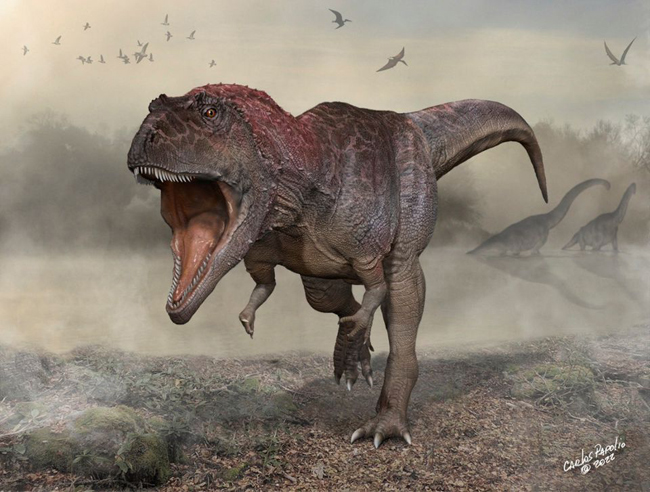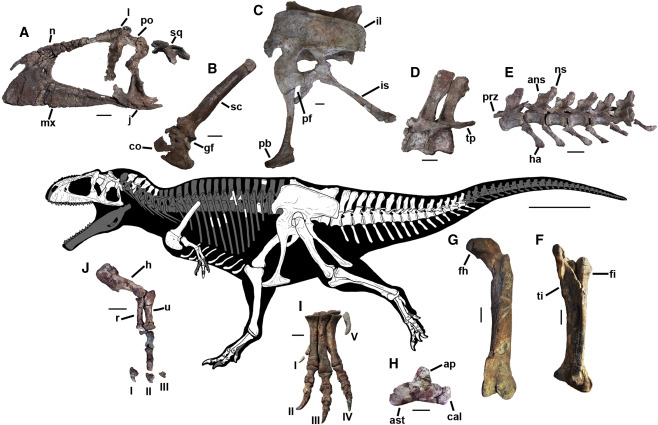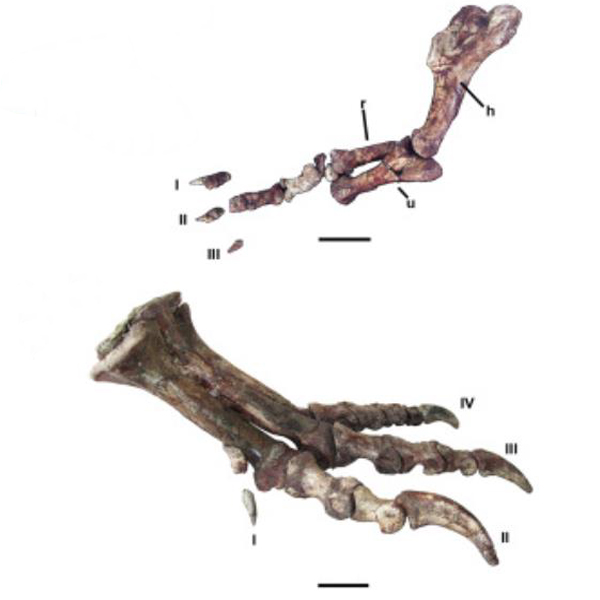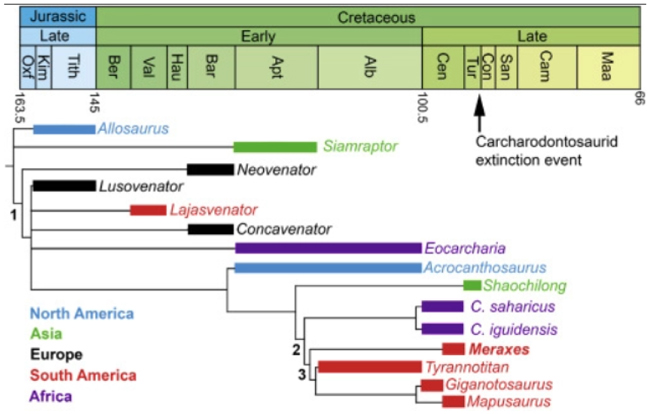Meraxes gigas – New Giant Carcharodontosaurid from Argentina
A new giant, Late Cretaceous predatory dinosaur has been named based on fossils found in Argentina. The dinosaur, assigned to the Carcharodontosauridae has been named Meraxes gigas and its fossilised remains represent the most complete carcharodontosaurid specimen found to date in the Southern Hemisphere.
The giant, South American predatory dinosaur Giganotosaurus which featured in the latest instalment of the “Jurassic Park/Jurassic World” movie franchise is just one of a poorly known group of theropod dinosaurs that were the apex predators in many terrestrial environments during the Cretaceous. Although, most dinosaur fans can name many carcharodontosaurids, these meat-eaters remain enigmatic and most genera have been described based on fragmentary remains. All that has changed with the publication of a scientific paper describing Meraxes gigas from the Upper Cretaceous Huincul Formation of northern Patagonia (Argentina).

A Giant Predator with Short Arms
Writing in the scientific journal “Current Biology” the researchers who include Juan Canale (Universidad Nacional de Río Negro, Argentina), suggest that M. gigas was around eleven metres long and weighed around four tonnes (estimated 4.26 tonnes). The skull bones, which represent one of the most complete large theropod skulls ever found, indicate a skull length of 1.27 metres, but its arms were disproportionately small. Like other Cretaceous apex predators, the tyrannosaurs and the abelisaurids, this dinosaur had very short arms. Arms so short that they could not reach its own mouth.
Lead author Juan Canale commented:
“I’m convinced that those proportionally tiny arms had some sort of function. The skeleton shows large muscle insertions and fully developed pectoral girdles, so the arm had strong muscles. They may have used the arms for reproductive behaviour such as holding the female during mating or support themselves to stand back up after a break or a fall.”

The fossils found in Huincul Formation exposures (late Cenomanian to Turonian) in Las Campanas Canyon some 14 miles southwest of Villa El Chocón, (Neuquén Province, Argentina), also include an almost complete right arm (j, in the image above). This limb, one of the most complete of any derived carcharodontosaurid described to date, is comparatively short and provides evidence to support the idea that many carcharodontosaurids had reduced forelimbs similar to those observed in abelisaurids such as Carnotaurus and most famously in Tyrannosaurus rex.
The researchers propose that forelimb reduction among three lineages of large-bodied predators is an example of convergent evolution, whereby not closely related organisms evolve the same traits. The fossils of Meraxes gigas show a remarkable degree of parallelism between latest-diverging tyrannosaurids and carcharodontosaurids.

Helping to Define the Size of Giganotosaurus (G. carolinii)
Meraxes has the most complete cranium of any Carcharodontosaurinae, with a total skull length estimated at 1.27 metres which is comparable to the most complete specimen of Acrocanthosaurus (A. atokensis) with a skull size of 1.23 metres. Giganotosaurus has the next most complete skull among carcharodontosaurids, but it is missing part of the maxilla and several other bones, so estimating its total length has been problematical. Although the head of Meraxes was not as wide as the head of Giganotosaurus, the cranium of Meraxes is sufficiently similar to G. carolinii to permit an estimate for the length of the Giganotosaurus skull to be made. Based on this comparison, the skull of the largest Giganotosaurus specimen would have been around 1.62 metres long, making it one of the longest theropod skulls known to science.

The discovery of yet another super-sized carcharodontosaurid from Argentina demonstrates the high diversity of these theropods shortly before their extinction. Parallels can be drawn between the diversity of South American carcharodontosaurids and tyrannosaurs known from the Campanian faunal stage in western North America.
There are no reliable records of carcharodontosaurids in South America beyond the end of the Turonian stage of the Late Cretaceous, this great clade of theropods are believed to have become extinct around 90 million years ago.
To read a related article about another South American theropod with reduced forelimbs and fingers like a T. rex: Gualicho Sticks Two Fingers up at T. rex.
What’s in a Name
The genus name (Meraxes) is named after a female dragon from the Song of Ice and Fire series of books by George R. R. Martin, upon which the hugely successful television series “Game of Thrones” was based. The species name (gigas) comes from the Greek meaning giant.
The scientific paper: “New giant carnivorous dinosaur reveals convergent evolutionary trends in theropod arm reduction” by Juan I. Canale, Sebastián Apesteguía, Pablo A. Gallina, Jonathan Mitchell, Nathan D. Smith, Thomas M. Cullen, Akiko Shinya, Alejandro Haluza, Federico A. Gianechini and Peter J. Makovicky published in Current Biology.

